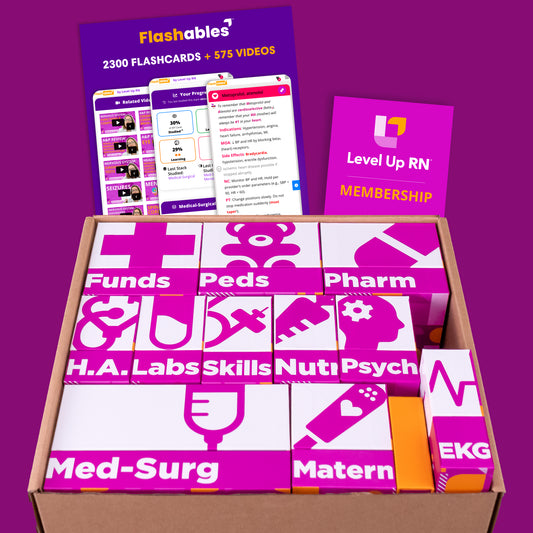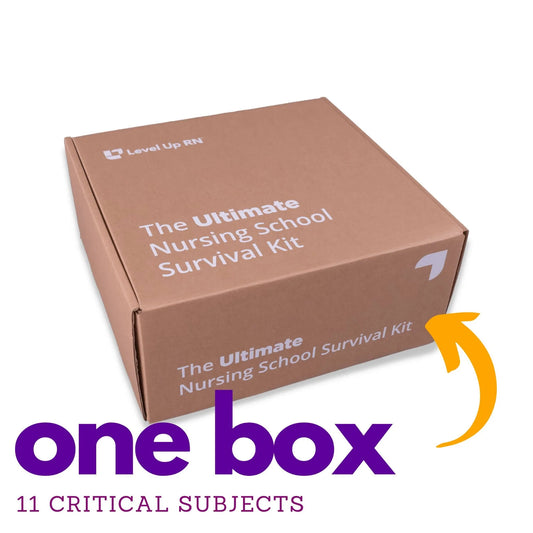Nursing Tips
Med-Surg (81)

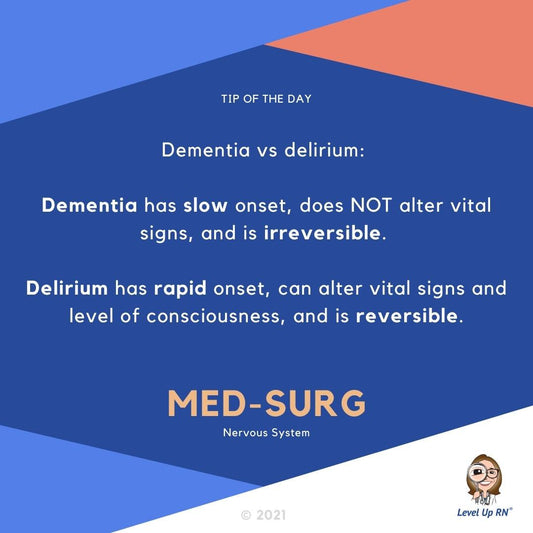
Dementia vs. delirium
Dementia vs delirium: Dementia has slow onset, does NOT alter vital signs, and is irreversible. Delirium has rapid onset, can alter vital signs and level of consciousness, and is reversible.
Dementia vs. delirium
Dementia vs delirium: Dementia has slow onset, does NOT alter vital signs, and is irreversible. Delirium has rapid onset, can alter vital signs and level of consciousness, and is reversible.

Lung capacity measurement
Patients with asthma should monitor their airway with a peak flow meter.
Lung capacity measurement
Patients with asthma should monitor their airway with a peak flow meter.
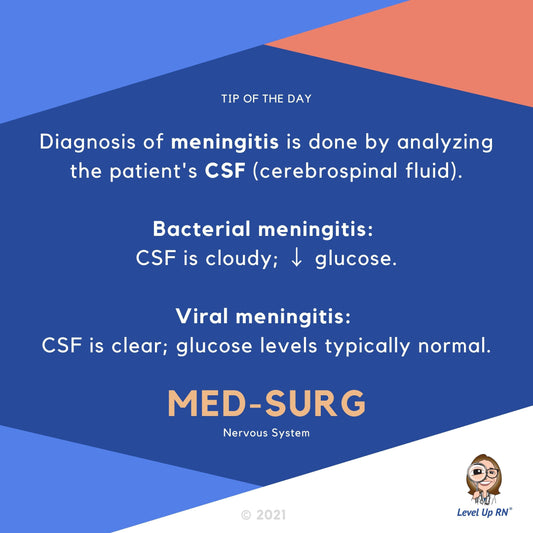
Meningitis diagnosis
Diagnosis of meningitis is done by analyzing the patient's CSF (cerebrospinal fluid).
Meningitis diagnosis
Diagnosis of meningitis is done by analyzing the patient's CSF (cerebrospinal fluid).
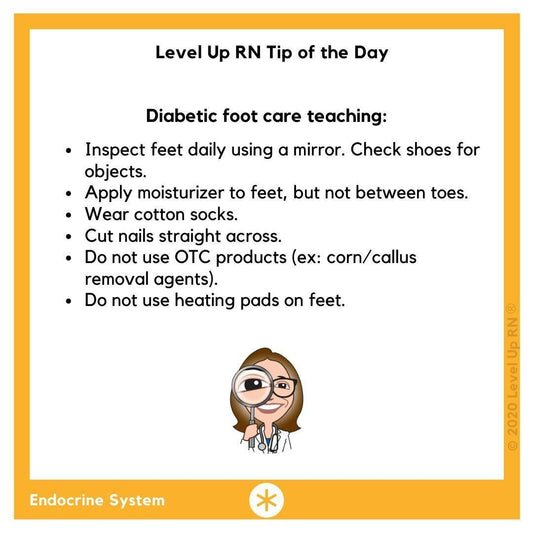
Diabetic Foot Care
Diabetic foot care teaching: Inspect feet; Apply moisturizer; Wear cotton socks; Cut nails straight across; Don't use OTC products or use heating pads on feet.
Diabetic Foot Care
Diabetic foot care teaching: Inspect feet; Apply moisturizer; Wear cotton socks; Cut nails straight across; Don't use OTC products or use heating pads on feet.
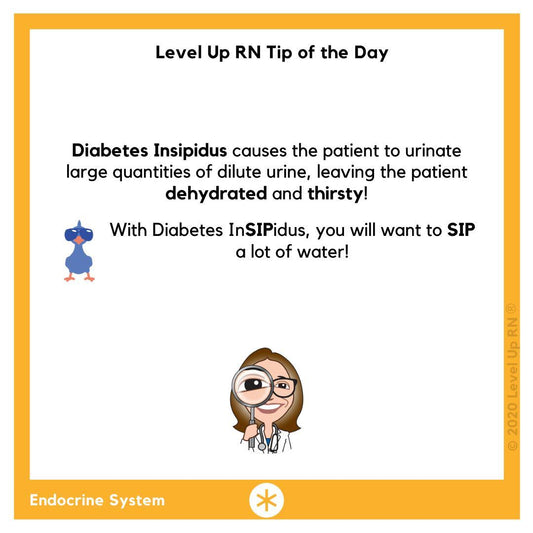
Diabetes Insipidus
With Diabetes InSIPidus, you will want to SIP a lot of water. Diabetes Insipidus causes the patient to urinate large quantities of dilute urine, leaving the patient dehydrated and thirsty!
Diabetes Insipidus
With Diabetes InSIPidus, you will want to SIP a lot of water. Diabetes Insipidus causes the patient to urinate large quantities of dilute urine, leaving the patient dehydrated and thirsty!
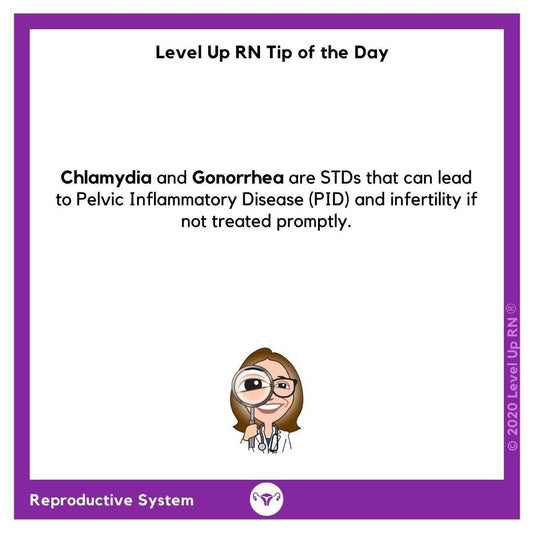
Chlamydia & Gonorrhea
Chlamydia and Gonorrhea are STDs that can lead to Pelvic Inflammatory Disease (PID) and infertility if not treated promptly.
Chlamydia & Gonorrhea
Chlamydia and Gonorrhea are STDs that can lead to Pelvic Inflammatory Disease (PID) and infertility if not treated promptly.

Innate v. Acquired Immunity
Innate vs. Acquired Immunity Pathophysiology
Innate v. Acquired Immunity
Innate vs. Acquired Immunity Pathophysiology
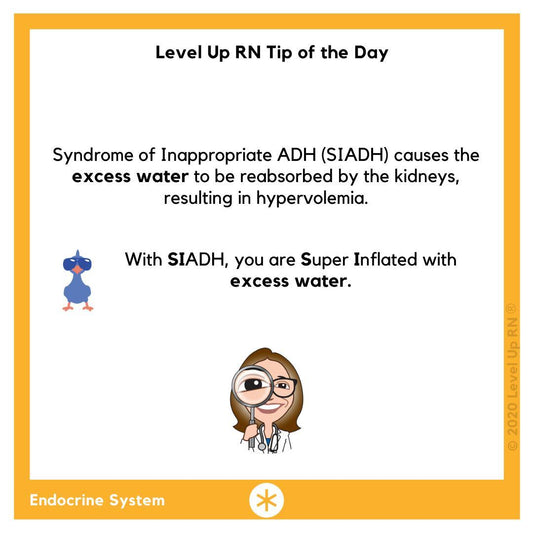
Syndrome of Inappropriate ADH
Syndrome of Inappropriate ADH (SIADH) causes the excess water to be reabsorbed by the kidneys, resulting in hypervolemia.
Syndrome of Inappropriate ADH
Syndrome of Inappropriate ADH (SIADH) causes the excess water to be reabsorbed by the kidneys, resulting in hypervolemia.
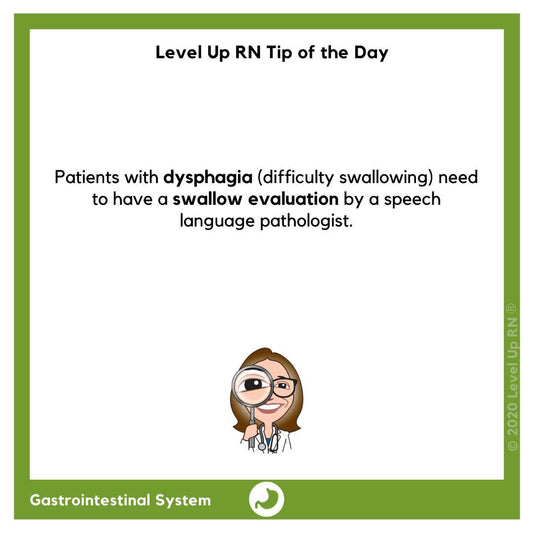
Dysphagia
Patients with dysphagia (difficulty swallowing) need to have a swallow evaluation by a speech language pathologist.
Dysphagia
Patients with dysphagia (difficulty swallowing) need to have a swallow evaluation by a speech language pathologist.

Rheumatoid Arthritis Labs
Expected labs with Rheumatoid Arthritis: Positive Rheumatoid Factor (RF) antibody and Positive ANA titer
Rheumatoid Arthritis Labs
Expected labs with Rheumatoid Arthritis: Positive Rheumatoid Factor (RF) antibody and Positive ANA titer

Menorrhagia
Menorrhagia = Excessive menstrual bleeding. This can result in anemia.If you have menorrhagia, it will make you want to rage!
Menorrhagia
Menorrhagia = Excessive menstrual bleeding. This can result in anemia.If you have menorrhagia, it will make you want to rage!
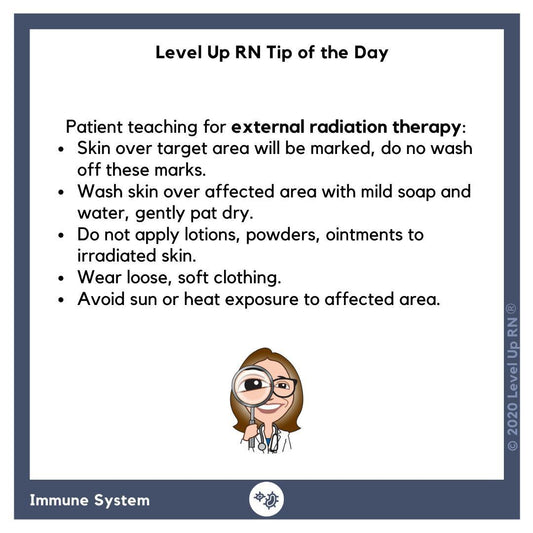
External Radiation Therapy Patient Teaching
Patient teaching for external radiation therapy.
External Radiation Therapy Patient Teaching
Patient teaching for external radiation therapy.
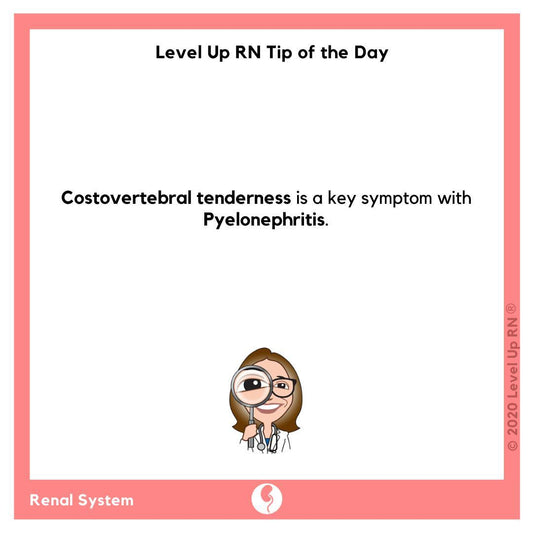
Pyelonephritis
Costovertebral tenderness is a key symptom with Pyelonephritis.
Pyelonephritis
Costovertebral tenderness is a key symptom with Pyelonephritis.

Hormone Replacement Therapy
Hormone Replacement therapy can be used to treat the signs/symptoms of menopause. However, it is important to remember that HT increases the risk of embolic events (DVT, MI, stroke) and...
Hormone Replacement Therapy
Hormone Replacement therapy can be used to treat the signs/symptoms of menopause. However, it is important to remember that HT increases the risk of embolic events (DVT, MI, stroke) and...
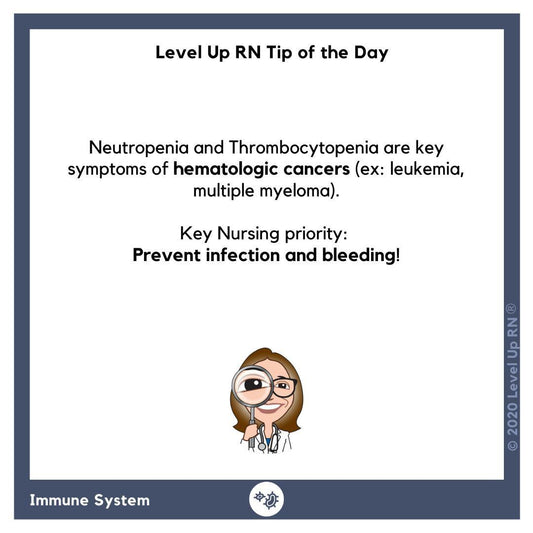
Neutropenia and Thrombocytopenia
Neutropenia and Thrombocytopenia are key symptoms of hematologic cancers (ex: leukemia, multiple myeloma). Key Nursing priority: Prevent infection and bleeding!
Neutropenia and Thrombocytopenia
Neutropenia and Thrombocytopenia are key symptoms of hematologic cancers (ex: leukemia, multiple myeloma). Key Nursing priority: Prevent infection and bleeding!
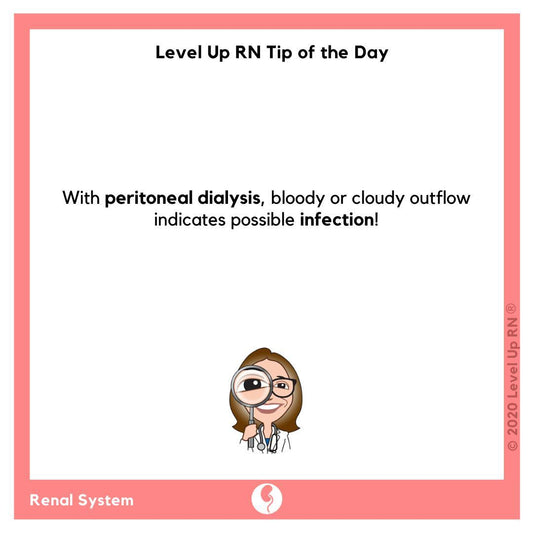
Peritoneal Dialysis
With peritoneal dialysis, bloody or cloudy outflow indicates possible infection!
Peritoneal Dialysis
With peritoneal dialysis, bloody or cloudy outflow indicates possible infection!
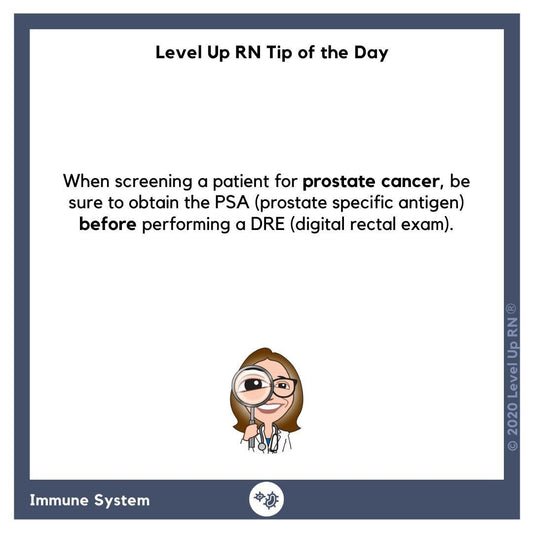
Prostate Cancer Screening
When screening a patient for prostate cancer, be sure to obtain the PSA (prostate specific antigen) before performing a DRE (digital rectal exam).
Prostate Cancer Screening
When screening a patient for prostate cancer, be sure to obtain the PSA (prostate specific antigen) before performing a DRE (digital rectal exam).
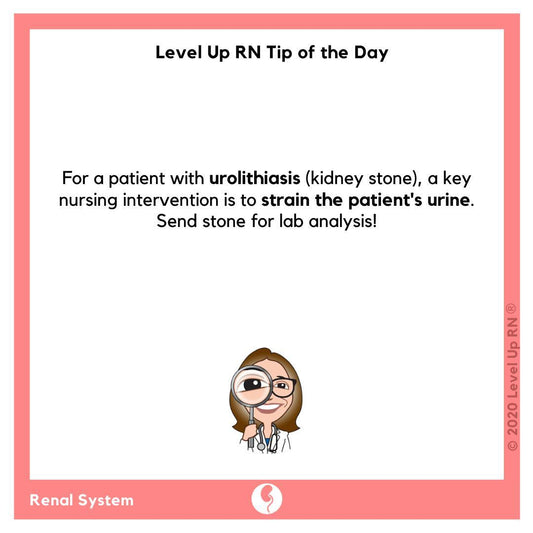
Urolithiasis
For a patient with urolithiasis (kidney stone), a key nursing intervention is to strain the patient's urine. Send stone for lab analysis!
Urolithiasis
For a patient with urolithiasis (kidney stone), a key nursing intervention is to strain the patient's urine. Send stone for lab analysis!
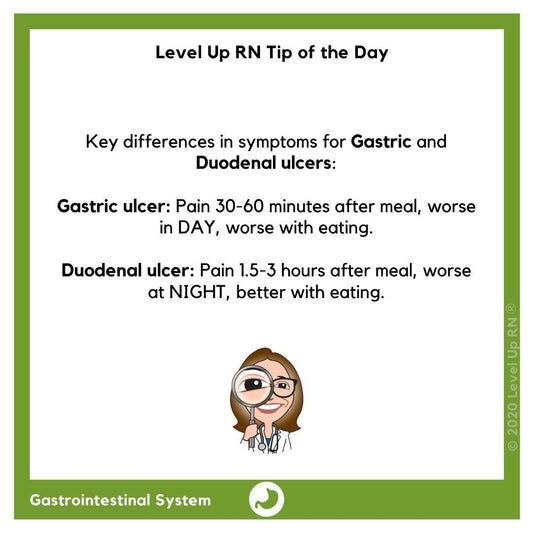
Gastric and Duodenal Ulcers
Key differences in symptoms for Gastric and Duodenal ulcers: Gastric ulcer: Pain 30-60 minutes after meal, worse in DAY, worse with eating. Duodenal ulcer: Pain 1.5-3 hours after meal, worse...
Gastric and Duodenal Ulcers
Key differences in symptoms for Gastric and Duodenal ulcers: Gastric ulcer: Pain 30-60 minutes after meal, worse in DAY, worse with eating. Duodenal ulcer: Pain 1.5-3 hours after meal, worse...
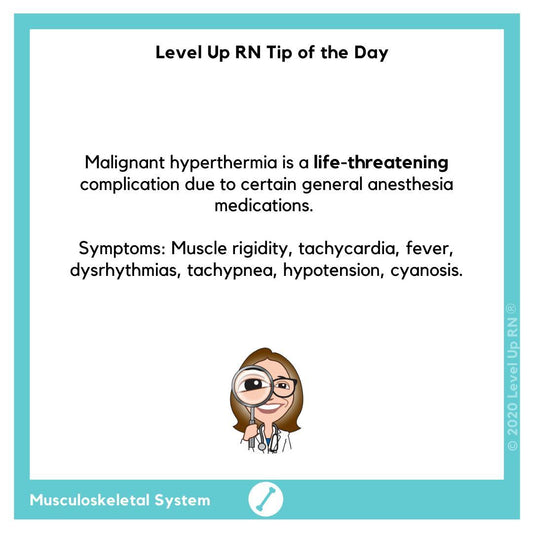
Malignant Hyperthermia
Malignant hyperthermia is a life-threatening complication due to certain general anesthesia medications. Symptoms: Muscle rigidity, tachycardia, fever, dysrhythmias, tachypnea, hypotension, cyanosis.
Malignant Hyperthermia
Malignant hyperthermia is a life-threatening complication due to certain general anesthesia medications. Symptoms: Muscle rigidity, tachycardia, fever, dysrhythmias, tachypnea, hypotension, cyanosis.
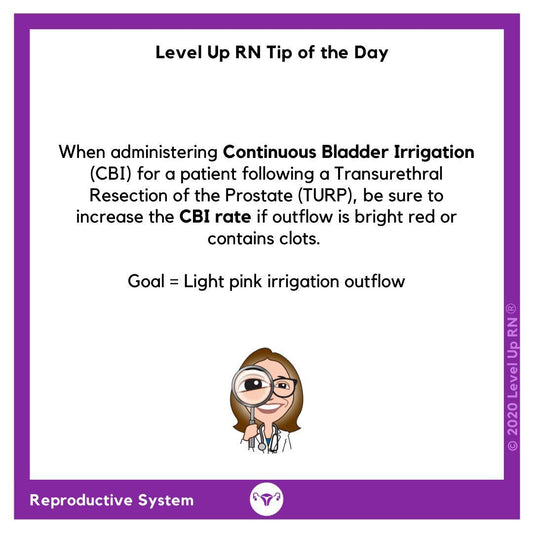
Continuous Bladder Irrigation
When administering Continuous Bladder Irrigation (CBI) for a patient following a Transurethral Resection of the Prostate (TURP), be sure to increase the CBI rate if outflow is bright red or...
Continuous Bladder Irrigation
When administering Continuous Bladder Irrigation (CBI) for a patient following a Transurethral Resection of the Prostate (TURP), be sure to increase the CBI rate if outflow is bright red or...
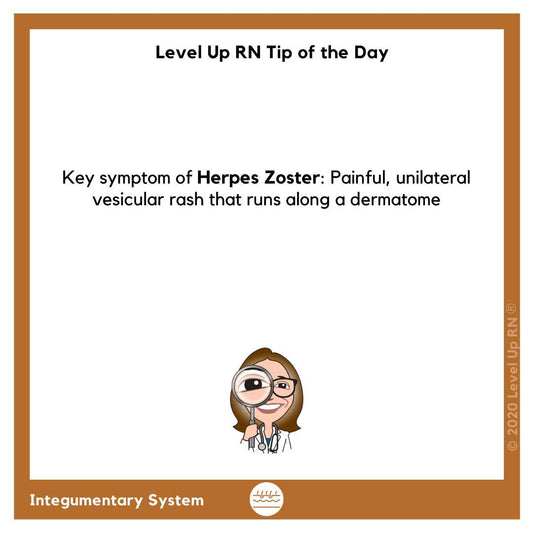
Herpes Zoster
Key symptom of Herpes Zoster: Painful, unilateral vesicular rash that runs along a dermatome
Herpes Zoster
Key symptom of Herpes Zoster: Painful, unilateral vesicular rash that runs along a dermatome
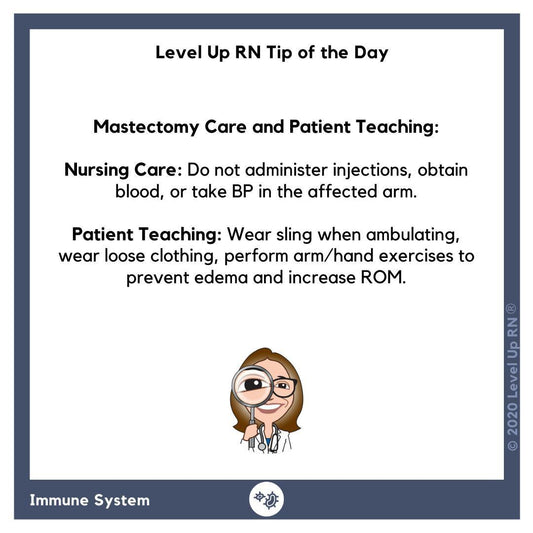
Mastectomy Care
Mastectomy Care and Patient Teaching: Nursing Care: Do not administer injections, obtain blood, or take BP in the affected arm. Patient Teaching: Wear sling when ambulating, wear loose clothing, perform...
Mastectomy Care
Mastectomy Care and Patient Teaching: Nursing Care: Do not administer injections, obtain blood, or take BP in the affected arm. Patient Teaching: Wear sling when ambulating, wear loose clothing, perform...

Patient Teaching for GERD
Patient teaching for GERD: Avoid fatty, fried, citrus, spicy foods. Eat smaller meals. Remain upright after meals. Avoid tight-fitting clothing. Lose weight (if applicable). Quit smoking. Elevate HOB with blocks.
Patient Teaching for GERD
Patient teaching for GERD: Avoid fatty, fried, citrus, spicy foods. Eat smaller meals. Remain upright after meals. Avoid tight-fitting clothing. Lose weight (if applicable). Quit smoking. Elevate HOB with blocks.
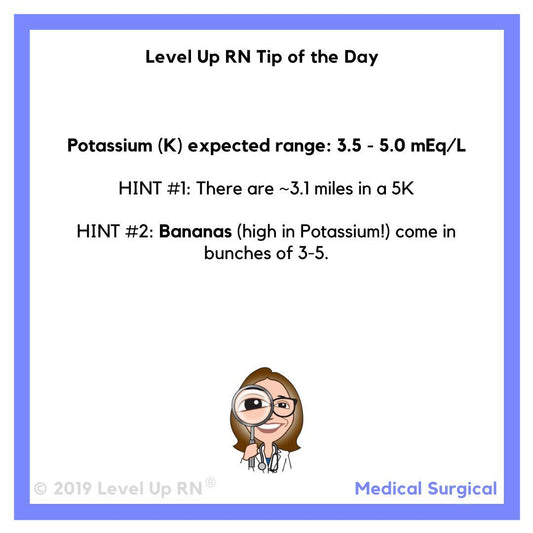
Potassium Ranges
Potassium (K) expected range: 3.5 - 5.0 mEq/L HINT #1: There are ~3.1 miles in a 5K HINT #2: Bananas (high in Potassium!) come in bunches of 3-5.
Potassium Ranges
Potassium (K) expected range: 3.5 - 5.0 mEq/L HINT #1: There are ~3.1 miles in a 5K HINT #2: Bananas (high in Potassium!) come in bunches of 3-5.

Magnesium Ranges
Magnesium (Mg) expected range: 1.3 - 2.1 mEq/L HINT: MGs are very small British cars - you can only fit 1-2 people in them.
Magnesium Ranges
Magnesium (Mg) expected range: 1.3 - 2.1 mEq/L HINT: MGs are very small British cars - you can only fit 1-2 people in them.
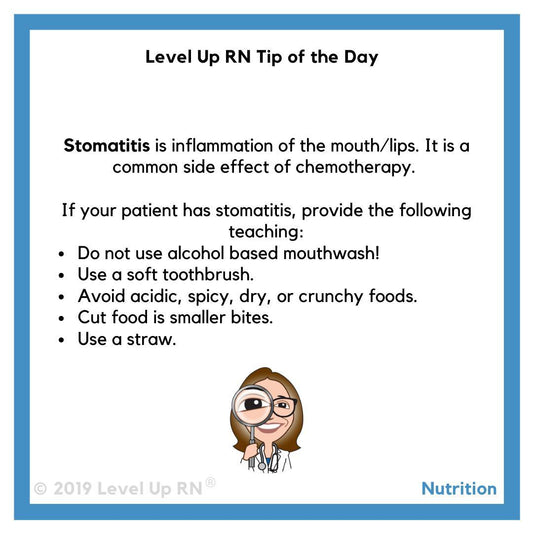
Stomatitis
Stomatitis is inflammation of the mouth/lips. It is a common side effect of chemotherapy. If your patient has stomatitis, provide the following teaching: Do not use alcohol based mouthwash! Use...
Stomatitis
Stomatitis is inflammation of the mouth/lips. It is a common side effect of chemotherapy. If your patient has stomatitis, provide the following teaching: Do not use alcohol based mouthwash! Use...
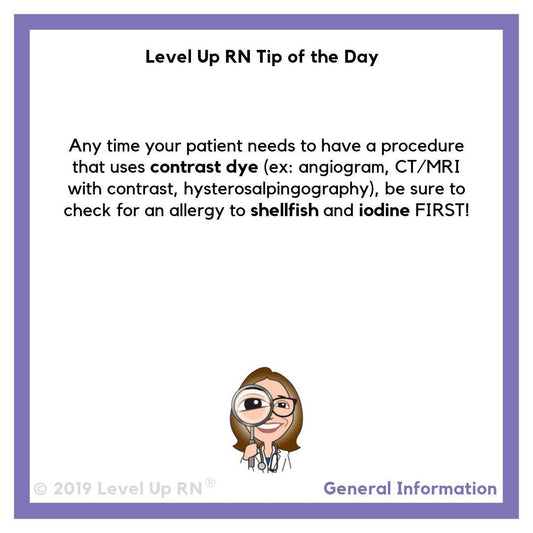
Contrast Dye
Any time your patient needs to have a procedure that uses contrast dye (ex: angiogram, CT/MRI with contrast, hysterosalpingography), be sure to check for an allergy to shellfish and iodine...
Contrast Dye
Any time your patient needs to have a procedure that uses contrast dye (ex: angiogram, CT/MRI with contrast, hysterosalpingography), be sure to check for an allergy to shellfish and iodine...
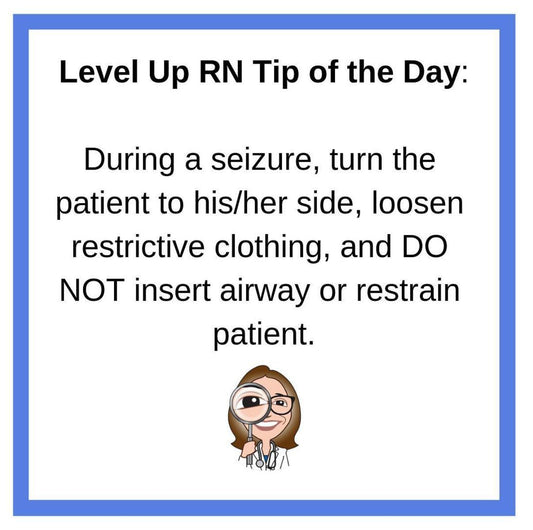
How to treat a seizure
During a seizure, turn the patient to his/her side, loosen restrictive clothing, and DO NOT insert airway or restrain patient.
How to treat a seizure
During a seizure, turn the patient to his/her side, loosen restrictive clothing, and DO NOT insert airway or restrain patient.
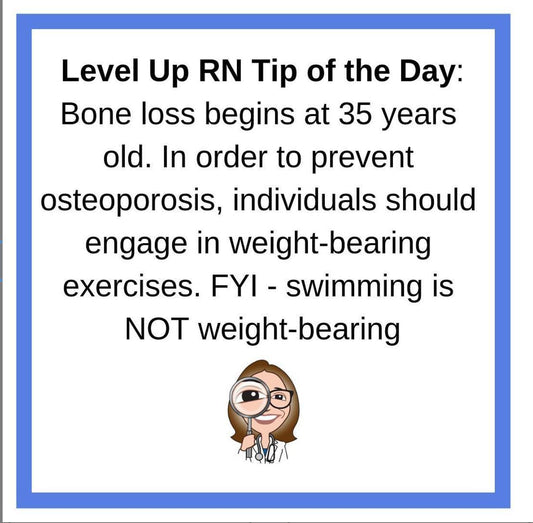
Bone loss and aging
Bone loss begins at 35 years old. In order to prevent osteoporosis, individuals should engage in weight-bearing exercises. FYI - swimming is NOT weight-bearing.
Bone loss and aging
Bone loss begins at 35 years old. In order to prevent osteoporosis, individuals should engage in weight-bearing exercises. FYI - swimming is NOT weight-bearing.

Blood transfusion reaction
If a patient has a blood transfusion reaction: stop the transfusion, infuse 0.9% NACL through a separate line, and be sure to send the blood bag back to the lab....
Blood transfusion reaction
If a patient has a blood transfusion reaction: stop the transfusion, infuse 0.9% NACL through a separate line, and be sure to send the blood bag back to the lab....
Filter Articles
Shop
The Ultimate Nursing School Survival Kit - with Flashables and Membership
4.875 / 5.0
(240) 240 total reviews
Regular price $349.95Regular priceUnit price / per$817.95Sale price $349.95SaleVideos by Subject
Tips & More
Exam Information
Subscribe


